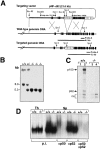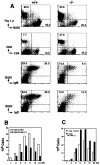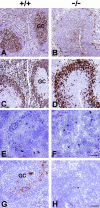Nuclear factor (NF)-kappa B2 (p100/p52) is required for normal splenic microarchitecture and B cell-mediated immune responses
- PMID: 9432976
- PMCID: PMC2212102
- DOI: 10.1084/jem.187.2.185
Nuclear factor (NF)-kappa B2 (p100/p52) is required for normal splenic microarchitecture and B cell-mediated immune responses
Abstract
The nfkb2 gene is a member of the Rel/NF-kappa B family of transcription factors. COOH-terminal deletions and rearrangements of this gene have been associated with the development of human cutaneous T cell lymphomas, chronic lymphocytic leukemias, and multiple myelomas. To further investigate the function of NF-kappa B2, we have generated mutant mice carrying a germline mutation of the nfkb2 gene by homologous recombination. NF-kappa B2-deficient mice showed a marked reduction in the B cell compartment in spleen, bone marrow, and lymph nodes. Moreover, spleen and lymph nodes of mutant mice presented an altered architecture, characterized by diffuse, irregular B cell areas and the absence of discrete perifollicular marginal and mantle zones; the formation of secondary germinal centers in spleen was also impaired. Proliferation of NF-kappa B2-deficient B cells was moderately reduced in response to lipopolysaccharide, anti-IgD-dextran, and CD40, but maturation and immunoglobulin switching were normal. However, nfkb2 (-/-) animals presented a deficient immunological response to T cell-dependent and -independent antigens. These findings indicate an important role of NF-kappa B2 in the maintenance of the peripheral B cell population, humoral responses, and normal spleen architecture.
Figures








References
-
- Schmid RM, Perkins ND, Duckett CS, Andrews PC, Nabel GJ. Cloning of an NF-κB subunit which stimulates HIV transcription in synergy with p65. Nature. 1991;352:733–736. - PubMed
-
- Mercurio F, Didonato J, Rosette C, Karin M. Molecular cloning and characterization of a novel Rel/NF-κB family member displaying structural and functional homology to NF-κB p50/p105. DNA Cell Biol. 1992;11:523–537. - PubMed
-
- Neri A, Chang CC, Lombardi L, Salina M, Corradini P, Maiolo AT, Chaganti RS, Dalla-Favera R. B cell lymphoma–associated chromosomal translocation involves candidate oncogene lyt-10, homologous to NF-κB p50. Cell. 1991;67:1075–1087. - PubMed
-
- Migliazza A, Lombardi L, Rocchi M, Trecca D, Chang C-C, Antonacci R, Fracchiolla NS, Ciana P, Maiolo AT, Neri A. Heterogeneous chromosomal aberrations generate 3′ truncations of the NFKB2/lyt-10 gene in lymphoid malignancies. Blood. 1994;84:3850–3860. - PubMed
MeSH terms
Substances
LinkOut - more resources
Full Text Sources
Other Literature Sources
Molecular Biology Databases
Research Materials
Miscellaneous

